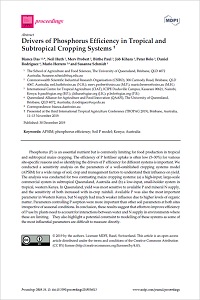Drivers of Phosphorus Efficiency in Tropical and Subtropical Cropping Systems
Phosphorus (P) is an essential nutrient but is commonly limiting for food production in tropical
and subtropical maize cropping. The efficiency of P fertiliser uptake is often low (5–30%) for various
site-specific reasons and so identifying the drivers of P efficiency for different systems is important. We
conducted a sensitivity analysis on the parameters of a well-established cropping systems model
(APSIM) for a wide range of soil, crop and management factors to understand their influence on yield.
The analysis was conducted for two contrasting maize cropping systems: (a) a high-input, large-scale
commercial system in subtropical Queensland, Australia and (b) a low-input, small-holder system in
tropical, western Kenya. In Queensland, yield was most sensitive to available P and mineral N supply,
and the sensitivity of both increased with in-crop rainfall. Available P was also the most important
parameter in Western Kenya, but N supply had much weaker influence due to higher levels of organic
matter. Parameters controlling P sorption were more important than other soil parameters at both sites
irrespective of seasonal conditions. In conclusion, these results suggest that efforts to improve efficiency
of P use by plants need to account for interactions between water and N supply in environments where
these are limiting. They also highlight a potential constraint to modelling of these systems as some of
the most influential parameters are difficult to measure directly.

